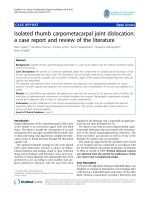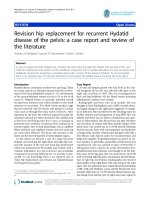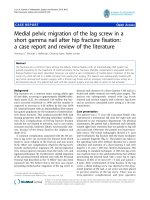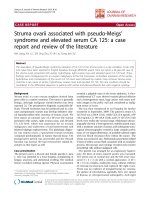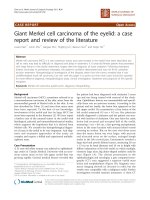báo cáo hóa học:" Isolated thumb carpometacarpal joint dislocation: a case report and review of the literature" potx
Bạn đang xem bản rút gọn của tài liệu. Xem và tải ngay bản đầy đủ của tài liệu tại đây (1.88 MB, 5 trang )
CAS E REP O R T Open Access
Isolated thumb carpometacarpal joint dislocation:
a case report and review of the literature
Elias Fotiadis
1*
, Theodoros Svarnas
1
, Christos Lyrtzis
1
, Alexis Papadopoulos
1
, Panagiotis Akritopoulos
2
,
Byron Chalidis
3
Abstract
Background: Isolated thumb carpometacarpal dislocation is a rare injury pattern and the optimal treatment option
is still controversial.
Case Description: We present a 27-year-old basketball player who underwent an isolated dorsal dislocation of the
thumb carpometacarpal joint after a fall. The dislocation was successfully reduced by closed means but the joint
was found to be grossly unstable. Due to inherent instability, repair of the ruptured dorsoradial ligament and joint
capsule was performed.
The ligament was detached from its proximal insertion into trapezium and subsequently stabilized via suture
anchors. The torn capsule was repaired in an end-to-end fashion and immobilization of the joint was applied for 6
weeks.
Results: At 3-year follow up evaluation the patient was pain free and returned to his previous level of activity. No
restriction of carpometacrpal movements or residual instability was noticed. Radiographic examination showed
normal joint alignment and no signs of subluxation or early osteoarthritis.
Conclusion: Surgical stabilization of the dorsal capsuloligamentous complex may be considered the selected
treatment option in isolated carpometacarpal joint dislocations, that remain unstable after closed reduction in
young and high demand patients.
Level of Clinical Evidence: Level IV
Introduction
Isolated dislocation of the carpometacarpal (CMC) joint
of the thumb is an uncommon upper limb and hand
injury. The lesion is usually the consequence of an axial
transmitted force thr ough a partially flexed thumb. Due
to thick and strong volar ligamentous complex the dislo-
cation occurs in dorsal direction through the thin dorsal
capsule [1,2].
The optimal treatment strategy for the acute thumb
CMC join t dislocation remains a subject of debate.
Closed reduction and casting, closed or open reduction
along with transfixion with Kirschner wires and recon-
struction of dorsal ligament and capsuloraphy have been
performed so far according to joint stability and sur-
geon’ s preference. However, only few cases have been
reported in the literature and a universally accepted pro-
tocol has not been developed yet [3].
We report a case with an acute isolated thumb carpo-
metacarpal dislocation that was treated with reconstruc-
tion of the dorsal capsuloligamentous structures. The
three-year follow up outcome, as well as review of the
literature for similar cases are presented.
This study was approved by the scientific review board
at our hospital and was conducted in accordance with
the World Medical Association Declaration of Helsinki
of 1964, as revi sed in 1983. Writt en informed consent
was obtained from the patient for publication of this
case report and accompanying images.
Case Description
A 27-year-old, right-hand dominant basketball player was
admitted on emergency department of our hospital, after
a fall during a basketball game and injury of the right
hand. Clinical examination revealed a deformity and
* Correspondence:
1
Orthopaedic Department, General Hospital of Veria, (Verias-Asomaton), Veria,
(59100), Greece
Fotiadis et al. Journal of Orthopaedic Surgery and Research 2010, 5:16
/>© 2010 Fotiadis et al; licensee BioMed Central Ltd. This is an Op en Access article distributed under the terms of the Creative Commons
Attribution License ( which permits unrestrict ed use, distribution, and reproduction in
any medium, provided the original work is properly cited .
swelling at the dorsoradial side of the hand in association
with tenderness and pain in thumb movements. Antero-
posterior and oblique hand a nd thumb radiographs
demonstrated an isolated dorsal dislocation of the CMC
joint. No fracture signs were identified (Figure 1).
Intra-articular injection of local anaesthetic (xylocaine
2%) was followed by closed reduction of the carpometacar-
pal joint dislocation. However, the joint found to be
grossly unstable and reconstruction of the dorsal capsulo-
ligamentous complex occurred. The procedure was per-
formed within few hours of the injury under regional
anaesthesia using a dorsoradial approach. The dorsoradial
ligament of CMC joint wa s found to be completely torn
from its proximal insertion leaving a small cuff attached
on the trapezium. The joint capsule was also transversely
torn in its mid-substance but no articular cartilage lesions
in both joint sides were evident. (Figure 2). The volar liga-
ment was remained also intact. After debridement of the
dorsal surface of the trapezium the dorsoradial ligament
was stabilized onto trapezium using a Mini-Mitec suture
anchor loaded with a 2-0 suture material (Ethibond).
Furthermore, the CMC joint capsule was r epaired in an
end-to-end fashion with 3-0 Vicryl interrupted stitches.
Wound closure was followed by application of a short-arm
spica cast for approximately 6 weeks. Afterwards, active
and passive movements in the joint were commenced but
any hand-played sports were prohibited for another 6
weeks.
Results
At 3-year follow-up, the patient was pain free and
returned to the pre-injury level of activity. No limitation
of thumb carpometacarpal joint mobility or residual
instability was observed (Figure 3). Radiographic exami-
nation revealed normal joint anatomy without any signs
of subluxation or early osteoarthritis (Figure 4).
Figure 1 Anteroposterior radiograph of the right hand. Isolated
thumb CMC joint dislocation is evident.
Figure 2 Intraoperative ph otograph of the dorsal aspect of
carpometacarpal joint. The dorsoradial ligament (black arrow) has
been detached from its attachment to trapezium. The capsule
(double white arrow) has been also transversely torn exposing the
joint and the base of 1
st
metacarpal (white arrow).
Figure 3 Appearance of the right hand 3 years post-
operatively. The patient had normal and painless thumb
movement.
Fotiadis et al. Journal of Orthopaedic Surgery and Research 2010, 5:16
/>Page 2 of 5
Discussion
The curved articular surfaces of CMC joint provide only
limited stability, compared to the ligaments embedded
within the joint capsule. Ligaments do not only repre-
sent the primary source of joint stability, but also set
the limits of motion in conjunction with the passive ten-
sion of muscles [4]. Therefore, their integrity is essential
to maintain the static and dynamic stability between the
1
st
metacarpal bone and trapezium. Excessive laxity of
the ligaments, such as after CMC dislocation, may lead
to joint instability and subsequently to degeneration of
the articular cartilage [4].
Isolated CMC dislocation is associated with various
degrees of joint capsule and liga ment damage. The volar
or anterior oblique ligament is a short and strong struc-
ture that was considered for many years the basic key
stabilizer for preventing dorsal dislocation of the joint
[1]. Bettinger et al. [5] were further reported that the
anterior oblique as well as the radial collateral and the
ulnar collateral ligaments should be considered the main
dynamic stabilizers of the thumb.
However, Strauch et al [6] in a cadaveric found that
the dorsoradial ligament complex was the primary
restraint to dorsal dislocation and responsible for
obtaining joint stability in thumb opposition. Moreover,
the authors found that it could be also responsible for
joint stability in thumb opposition. This finding was
confirmed clin ically from Shah and Patel [7] who
noticed no di sruption of volar capsule or li gament in 4
cases with thumb CMC dislocation. Conversely, the dor-
sal capsule and ligament found to be avulsed or torn. In
our patient, we similarl y observed that the dorsal capsu-
loligamentous complex was completely ruptured but the
integrity of volar ligament was well preserved.
The healing potential of dorsal elements without any
surgical intervention is still a controversial issue and the
indications for performing early ligament reconstruction
have not been clearly defined. Conservative or minimally
invasive methods (percutaneous pinning) have been
appliedbysomeauthors.(Table1)WattandHooper
[8] described the result of closed reduction and cast or
cast and K-wire fixation in 12 patients. One third of
patients who treated with cast only and two thirds of
patients who treated with cast and K-wire fixation had
an unstable and dorsally subluxating joint, which caused
weakness and discomfort on hand gripping. Jacobsen
and Elberg [3] reported a case with isolated thumb
CMC dislocation that was treated with closed reduction
and K-wire fixation. Eighteen months post-injury, slight
instability and radial subluxation of the first metacarpal
bone was found. In the la tter scenario, ligament re con-
struction by using the Eaton and Little r technique can
be applied. The operation has offered good functional
results and adequate pain relief in patients with chronic
CMC instability after traumatic dislocation of the thumb
[9].
On the other hand, Bosmans et al [1] obtained good
result in 2 patients with isolated thumb CMC joint dis-
location after closed reduction and cast. Three year
post-injury the patients were pain free and had normal
range of motion. Similarly, a very satisfactory outcome
was noticed by Khan et al [10] in another patient with
bilateral thumb CMC dislocation that treated with
closed reduction and cast. Kural et al [11] achieved also
good result after closed reduction and cast of a unilat-
eral thumb CMC dislocation.
Simonian and Trumble [12] compared early ligamen-
tous reconstruction with closed reduction and pinning.
Four out of 8 patients who initially treated with closed
reduction and percutaneous pinning showed recurrent
instability. In reconstructive group (minimum follow-up
period of 2 years), painless full range of motion and nor-
mal grip strength were observed. A good result was seen
also from Chen VT [2] in a patient who treated with
dorsal ligament reconstruction. Shah and Patel [7] advo-
cated that open reduction and K-wire fixation without
ligament reconstruction might not be adequate for this
type of injury. In their series 2 patients had dorsal
Figure 4 Anteroposterior radiograph of the ri ght hand 3 years
post-operatively. Good joint congruency without signs of
instability or osteoarthritis are seen.
Fotiadis et al. Journal of Orthopaedic Surgery and Research 2010, 5:16
/>Page 3 of 5
subluxatio n of thumb met acarpal bone after application
of the above technique. The remaining patients who
underwent open reduction and K-wire fixation or closed
reduction and percutaneous pinning respectively had
congruent joints.
The above cases point out the unpredictable outcome
of conservative or minimally operative treatment modal-
ities in stability of thumb CMC joint. Inadequate treat-
ment may increase the incidence of recurrent instability,
joint degeneration and chronic pain and negatively affect
the long-term functional result[11]. Bosmans et al [1]
suggested that a nonoperative protocol should be fol-
lowed in case of joint congruency after successful closed
reduction. The authors mentioned that ligament recon-
struction was not clearly justified and sh ould be avoided
in acute cases. However, it seems that closed or open
reduction and percutaneous pinning can not always
guarantee an optimum result and ligament r econstruc-
tion should not be considered a superfluous treatment
option.
Conclusion
We believe that an unstable thumb CMC joint after
closed reduction of dorsal dislocation probably illus-
trates a more serious damage in dorsal ligament and
joint capsule. In this case, dorsal capsuloraphy and liga-
ment repair may be of clear benefit particularly in
young athletes with high upper extremity demand.
Acknowledgements
Authors state that no funds have received for this study.
Author details
1
Orthopaedic Department, General Hospital of Veria, (Verias-Asomaton), Veria,
(59100), Greece.
2
1st Orthopaedic Department, Aristotle University of
Thessaloniki, (Ag. Dimitriou), Thessaloniki, (54622), Greece.
3
Orthopaedic
Department, Avenue Hospital, Melbourne, Australia.
Authors’ contributions
E. F. was a major contributor in writing the manuscript while B. C. was a
major contributor in writing and in editing the manuscript, as well. C. L. and
T.S. analyzed and interpreted the patient data regarding the injury. A. P. and
P.A. have been involved in drafting the manuscript.
Competing interests
The authors declare that they have no competing interests.
Received: 30 November 2009
Accepted: 10 March 2010 Published: 10 March 2010
References
1. Bosmans B, Verhofstad MHJ, Gosens T: Traumatic thumb carpometacarpal
joint dislocations. J Hand Surg 2008, 33A:438-441.
2. Chen VT: Dislocation of the carpometacarpal joint of the thumb. J Hand
Surg (Br) 1987, 12(2):246-51.
3. Jacobsen CW, Elberg JJ: Isolated carpometacarpal dislocation of the
thumb. Scand J Plast Reconstr Surg 1988, 22:185-186.
4. Neumann DA, Bielefeld T: The carpometacarpal joint of the thumb:
Stability, deformity and therapeutic intervention. J Orthop Sports Phys
Ther 2003, 33(7):386-399.
5. Bettinger PC, Linscheid RL, Berger RA, Cooney WP, An KN: An anatomic
study of the stabilizing ligaments of the trapezium and
trapeziometacarpal joint. J Hand Surg [Am] 1999, 24(4):786-798.
6. Strauch RJ, Behrman MJ, Rosenwasser MP: Acute dislocation of the
carpometacarpal joint of the thumb: an anatomic and cadaver study. J
Hand Surg 1994, 19A:93-98.
7. Shah J, Patel M: Dislocation of the carpometacarpal joint of the thumb. A
report of four cases. Clin Orthop Relat Res 1983, 175:166-169.
Table 1 Published cases with isolated thumb CMC dislocation in English literature
Study Year Number of
cases
Treatment Result
Shah J and Patel
7
Clin Orthop Relat Res
1983 4 A. Open reduction + pinning (2 patients)
B. Closed reduction pinning (1 patient)
C. Open reduction + cast in (1 patient)
A. Dorsal subluxation, mild arthritic changes.
B and C. No subluxation - Normal range of
motion
Watt N and Hooper G
8
J Hand Surg
1987 12 A. Closed reduction + cast (6 patients)
B. Closed reduction + cast after 3-21 days
(3 patients)
C. Closed reduction + pinning + cast (3
patients)
A. Asymptomatic instability
B. Pain and instability
C. No pain or instability
Chen VT
2
J Hand Surg (Br)
1987 1 Ligament reconstruction Good functional result
Jacobsen CW and Elberg JJ
3
Scand J Plast Reconstr Surg
Hand Surg
1988 1 Closed reduction + pinning Slight instability
Simonian PT and
Trumble TE
12
J Hand Surg (Am)
1996 17 A. Closed reduction + pinning (8 patients)
B. Early ligamentous reconstruction (9
patients)
A. Revision surgery for recurrent instability in 4
patients (50%)
B. Normal grip strength and range of motion
Kural C et al
11
Acta Orthop Traum Turc
2002 1 Closed reduction + cast No pain or instability
Khan AM et al
10
Am J Orthop
2003 1 Closed reduction + cast Good functional result
Bosmans et al.
1
J Hand Surg (Am)
2008 2 Closed reduction + cast No instability-Normal range of motion
Fotiadis et al. Journal of Orthopaedic Surgery and Research 2010, 5:16
/>Page 4 of 5
8. Watt N, Hooper G: Dislocation of the trapezio-metacarpal joint. J Hand
Surg [Br] 1987, 12B:242-245.
9. Akmaz I, Kiral A, Pehlivan O, Solakoglu C: Ligament reconstruction for the
chronic instability of the traumatic thumb carpometacarpal joint. Acta
Orthop Traumatol Turc 2003, 37(3):237-43.
10. Khan AM, Ryan MG, Teplitz GA: Bilateral carpometacarpal dislocations of
the thumb. Am J Orthop 2003, 32:38-41.
11. Kural C, Malkoc M, Ugras AA, Sen A: Isolated carpometacarpal dislocation
of the thumb: a case report. Acta Orthop Traumatol Turc 2002, 36(5):446-8.
12. Simonian PT, Trumble TE: Traumatic dislocation of the thumb
carpometacarpal joint: early ligamentous reconstruction versus closed
reduction and pinning. J Hand Surg [Am] 1996, 21(5):802-6.
doi:10.1186/1749-799X-5-16
Cite this article as: Fotiadis et al.: Isolated thumb carpometacarpal joint
dislocation: a case report and review of the literature. Journal of
Orthopaedic Surgery and Research 2010 5:16.
Submit your next manuscript to BioMed Central
and take full advantage of:
• Convenient online submission
• Thorough peer review
• No space constraints or color figure charges
• Immediate publication on acceptance
• Inclusion in PubMed, CAS, Scopus and Google Scholar
• Research which is freely available for redistribution
Submit your manuscript at
www.biomedcentral.com/submit
Fotiadis et al. Journal of Orthopaedic Surgery and Research 2010, 5:16
/>Page 5 of 5
